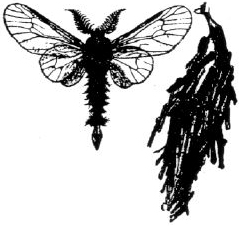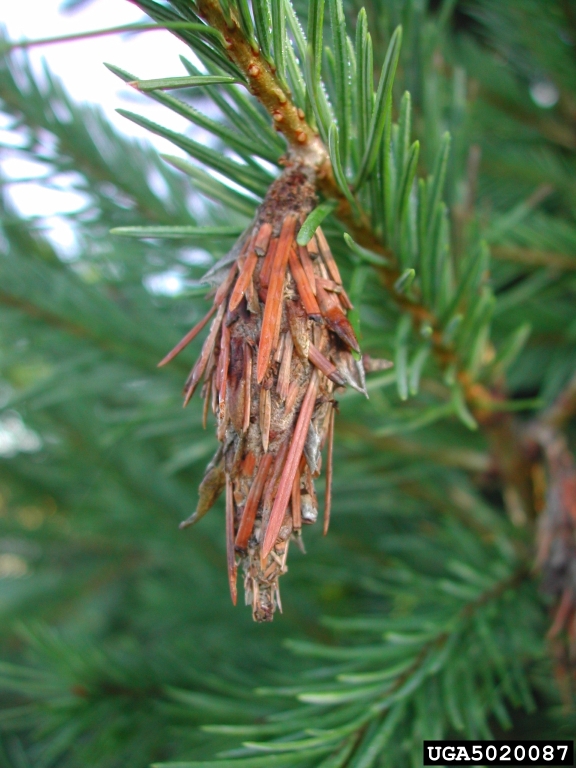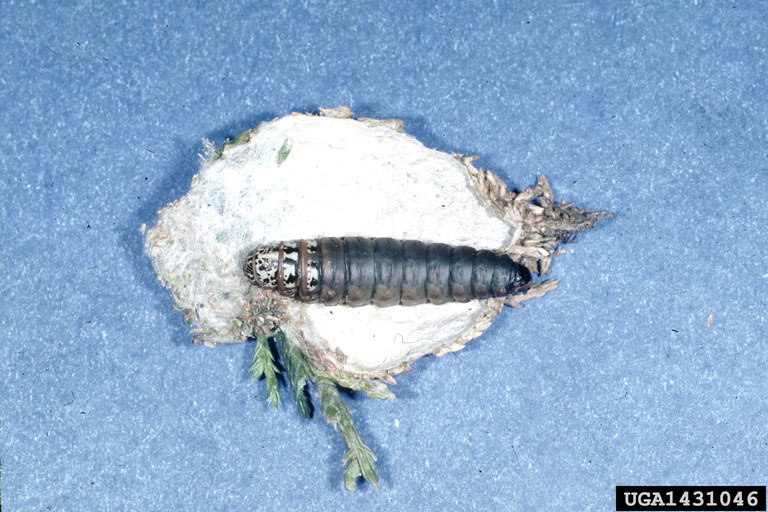 Bagworms - August 18, 2010 Jeff Schalau, Associate Agent, Agriculture & Natural Resources University of Arizona Cooperative Extension, Yavapai County Bagworms are unusual insects that are often considered pests in the central, eastern and southern U.S where they defoliate evergreen trees. Defoliation of coniferous evergreens can be a problem because these plants depend on these needles to conduct photosynthesis over several years. They are somewhat rare in Arizona and certainly less damaging to landscapes than they are in other parts of the country. Occasionally, their populations become noticeable on native sycamores along creeks in the Verde Valley, but most often people happen across a bagworm in their landscape. Bagworm species vary slightly in habits and life cycle, on evergreens the bagworm spends winter months in the egg stage within a cocoon-like, sealed bag produced by the female the previous fall. In the spring, tiny caterpillars hatch, lower themselves on silken strands to new foliage. Very soon after emerging, each tiny larval caterpillar begins spinning a protective bag around itself, leaving an opening at the head end to permit crawling about and feeding. As they feed, they attach small pieces of leaves or needles of the host plant to their bag. As anyone that has tried to tear one open can attest, the silk holding the bag together is very strong and cannot be easily torn open – it can most easily be cut open with sharp scissors. Caterpillars remain inside their bags and grow up to 2 inches long before pupating in late summer. Seven to 10 days later, the male bagworm moths wriggle out of the bottom of the bag leaving the empty pupal skin with the bag. Adult males have short (½ inch-long) clear wings, hairy black bodies and feathery antennae. They fly and seek out a female mate. Females do not develop into moths, but remain inside bags and resemble large maggots, with no functional eyes, legs, mouthparts or antennae. After mating, females produce a large clutch (500 to 1,000) of eggs and die. Some bagworm species spend winter months as partially-developed caterpillars that complete feeding and pupate in the spring. Bagworm caterpillars have chewing mouthparts. Across their range and among differing species, they feed on a wide range of broadleaf and evergreen trees and shrubs. These include arborvitae and other ornamental conifers, box elder, cedar, cypress, elm, fruit and nut trees, juniper, live oak, locust, maple, persimmon, pines, salt cedar, sumac, sycamore, wild cherry, willow and many other ornamental plants. Young bagworms feed only on the outer layers of cells of the foliage (called skeletonizing), but as they mature, they consume all but major leaf veins. Sometimes, infested plants develop more bagworms each year because adult females do not fly. During leaf-feeding, the caterpillars emerge from the top of the bag and hang onto the host plant with their legs and sometimes with a silken thread. The bottom of the bag remains open to allow fecal material (frass) to pass out of the bag. As mentioned previously, bagworms are not usually serious plant pests in Arizona. If significant damage occurs, hand-picking the bags and destroying them is a simple way of managing them. In late fall, you can put the bags in coffee cans or jars with coarse screening to allow any parasites in the bags, such as flies or parasitic wasps to emerge and escape. These natural biological control organisms will aid in controlling future bagworm populations. Many birds also feed on bagworms. Many Extension publications recommend pesticide applications to manage bagworms. These recommendations were developed for areas where bagworms cause significant damage. In our area, they are not usually present in large numbers and are simply an interesting member of the local ecosystem. As a final note, tent caterpillars and fall webworms are sometimes mistakenly called bagworms. However, these insects create large, translucent webs that contain multiple (often hundreds) of caterpillars. Bagworms are solitary and create opaque, leaf-covered shelters. Below are some images of bagworms.  Adult male moth and bagworm case  Bagworm case  Bagworm larva and cut open case |